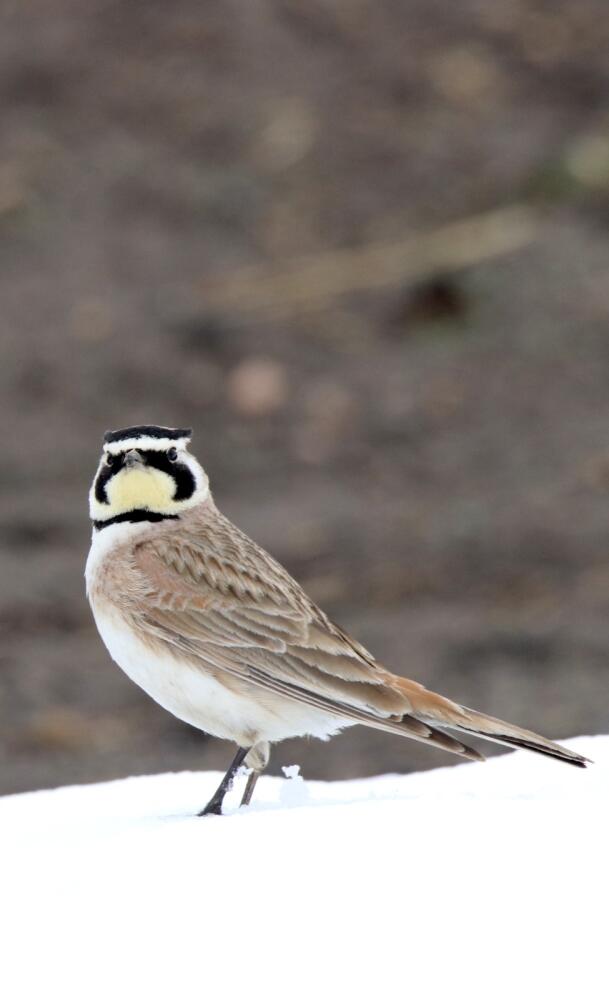Coming In from the Cold:
How the Last Ice Age Shaped Birds and Us
By Jay Cooney

A Horned Lark on the wintry plains of the Southern Rockies. A 46,000-year-old specimen was found frozen in Siberian permafrost, showing that the species diversified during the last ice age. Photo by the author.
When the peaks of the Sangre de Cristo Mountains become snowcapped, a flurry of bird adaptations sweeps across the foothills. We marvel at the continent-spanning journeys of migratory birds seeking warmer grounds, yet equally compelling is the resilience of species who spend the winter in place. To maintain calories and body temperature amid freezing conditions and resource scarcity, birds rely on an array of strategies involving movement and behavioral flexibility. Birds’ cold-weather adaptations were refined across millennia, reflecting a time in Earth’s history that may feel distant, but in fact has left a legacy in our own minds and bodies. The challenges of the last ice age honed the cleverness and hardiness of birds and fostered these same qualities in humanity. Seeking lessons from the volatile Pleistocene epoch might help us endure a modern world thrust into climate instability.
The extremes of winter have fashioned birds into supreme survivalists. Movement is a widespread strategy. Of the birds who winter in North America, 116 species embark on partial journeys, heading lower in elevation to find favorable conditions away from the alpine buildup of snow. This altitudinal migration is often observed at backyard bird feeders as a seasonal changing of the guard; flickers and juncos, for instance, will suddenly appear with the cold to pack on calories. For other species, seasonal savviness has transformed their physiology. Mountain Chickadees living at higher, colder elevations perform better in cognitive tests and possess a larger, more neuron- dense hippocampus (the region of the brain dedicated to spatial memory). The chickadee hippocampus expands in volume by 30% in the fall, aiding their memory of winter seed caches, before shrinking again in spring. Birds’ abilities to adjust their ranges and behavior to the cold were put to the test during the last ice age.
Across the period known popularly as the Ice Age and formally as the Pleistocene epoch, the advance and retreat of glaciers sculpted North America’s bird species. Due to recurring glacial cycles and dramatic climate swings, Pleistocene environments were extremely dynamic. Animals migrated within a shifting mosaic of spruce forests, wetlands, steppe-tundras, and fertile grasslands enriched by glacial silt. Many familiar American birds, including Black-capped and Carolina Chickadees, arose as distinct species when the expansion and contraction of forests isolated their populations. Spanning 2.6 million years ago to 11,700 years ago, the Pleistocene was very recent in terms of geological deep time, and its influence lingers.
Like songbirds shaped by glacial cycles, adaptability has been key to human success. The Pleistocene was humanity’s coming of age, encompassing over 90% of our species’ history and forming the basis for our ever-flexible behavior. As examined in The Dawn of Everything, Pleistocene societies often formed grand communal assemblies that congregated and dispersed with the seasons, possibly to prevent stagnation into rigid hierarchies. Human ecologist Paul Shepard envisioned ‘coming home to the Pleistocene,’ not by romanticizing a hunter-gatherer past, but by grounding our future in the reciprocal bonds with community and ecology that formed the human mind and body. Today, industrialism and individualism separate us from land and kinship, creating a disorienting mismatch between the connections we evolved for and the alienation imposed on us. Learning from the attunement and adaptability of birds, we can become more responsive and responsible to the needs of a rapidly destabilizing Earth.
Jay Cooney is a Naturalist at Wild Birds Unlimited of Santa Fe

